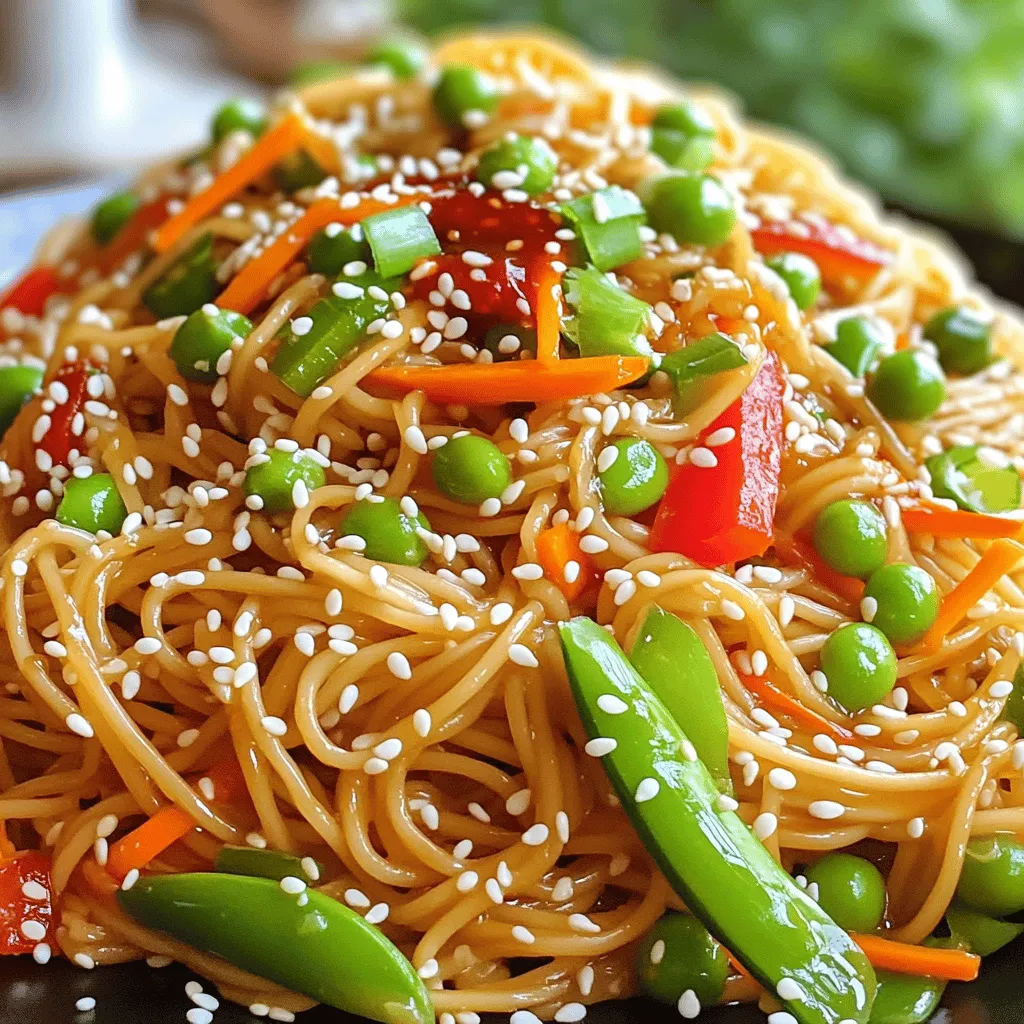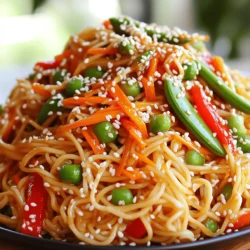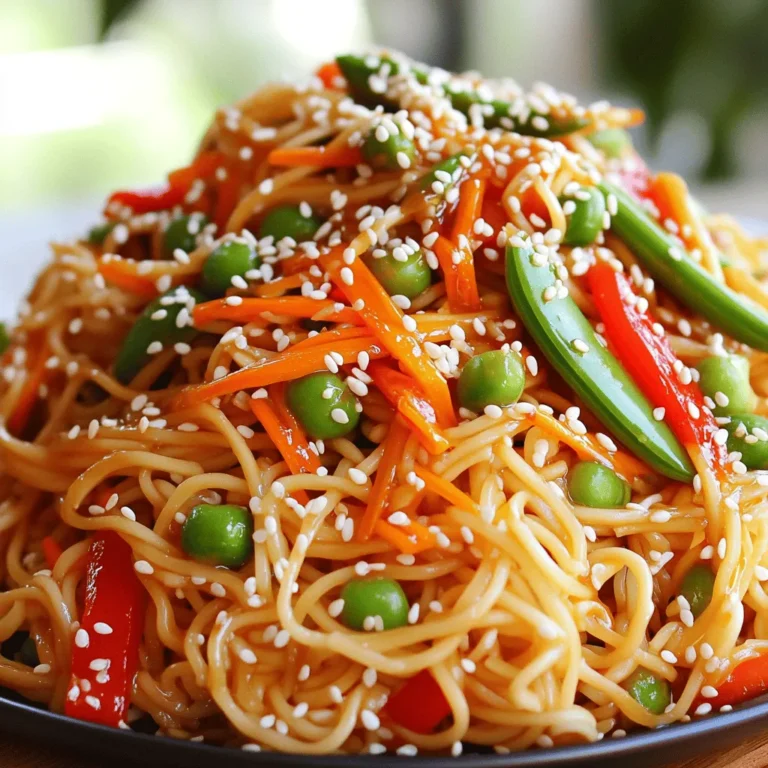Craving takeout but want to stay in? You’re in luck! My Spicy Sesame Noodles Takeout Fakeout Delight gives you all the bold flavors without the delivery fee. You can whip up this fun dish at home with just a few simple steps. Plus, I’ll share tips for the perfect taste and ways to customize it to your diet. Let’s dive into this tasty adventure!
Ingredients
Main Ingredients List
– 8 oz rice noodles
– 3 tablespoons sesame oil
– 2 tablespoons soy sauce (or tamari for gluten-free)
– 2 tablespoons sriracha (adjust to taste)
– 1 tablespoon rice vinegar
– 2 teaspoons honey or maple syrup
– 1 clove garlic, minced
– 1 teaspoon fresh ginger, grated
– 1 red bell pepper, julienned
– 1 cup shredded carrots
– 1 cup snap peas, trimmed
– 4 green onions, chopped
– 2 tablespoons sesame seeds
– Fresh cilantro for garnish (optional)
Special Ingredients for Authentic Flavor
Sesame oil is key for that rich taste. It brings warmth and depth. Sriracha adds heat and a hint of sweetness. Rice vinegar offers a nice tang. Honey or maple syrup balances the flavors. Fresh ginger and garlic give a lively kick. Each ingredient works together to create a bold dish.
Suggested Substitutions
If you can’t find rice noodles, use spaghetti or another type. Soy sauce can be swapped with coconut aminos for a lighter taste. For a vegan option, replace honey with agave syrup. You can change the veggies too! Try broccoli, bell peppers, or even zucchini. These swaps keep the dish fresh and fun.
Step-by-Step Instructions
Cooking the Rice Noodles
First, bring a large pot of water to a boil. Add 8 ounces of rice noodles to the water. Cook them based on the package instructions until they are tender. After cooking, drain the noodles and rinse them with cold water. This stops the cooking and keeps them from getting mushy. Set the noodles aside for later.
Preparing the Sauce
In a small bowl, mix together the sauce. You need 3 tablespoons of sesame oil, 2 tablespoons of soy sauce, and 2 tablespoons of sriracha. Add 1 tablespoon of rice vinegar, 2 teaspoons of honey or maple syrup, 1 minced clove of garlic, and 1 teaspoon of grated fresh ginger. Whisk everything together until well combined. If you like it spicier, add more sriracha.
Stir-Frying the Vegetables
Heat a large skillet or wok over medium-high heat. Pour in a tablespoon of sesame oil. Add the julienned red bell pepper, 1 cup of shredded carrots, and 1 cup of trimmed snap peas. Stir-fry the vegetables for about 3 to 5 minutes. They should be tender but still crisp, keeping that nice crunch.
Combining Noodles, Sauce, and Vegetables
Once the vegetables are ready, add the cooked rice noodles to the skillet. Pour the prepared sauce over the noodles and vegetables. Gently toss everything together for about 2 minutes. Make sure all the noodles are coated well with the sauce and heated through.
Garnishing and Serving
Take the skillet off the heat. Stir in 4 chopped green onions and 2 tablespoons of sesame seeds. For a fresh touch, you can add some cilantro on top if you like. Serve your spicy sesame noodles warm and enjoy the tasty flavors!
Tips & Tricks
Achieving the Perfect Flavor Balance
To get the best taste, mix your sauce well. The sauce has sesame oil, soy sauce, and sriracha. Each ingredient plays a role. The sesame oil adds richness, while soy sauce gives saltiness. Sriracha adds heat. Adjust the sriracha for your spice level. If you want more heat, add more sriracha. For less heat, dial it back.
Cooking Techniques for Best Texture
Texture makes a big difference in this dish. Cook the rice noodles until tender but not mushy. Rinse them with cold water to stop the cooking. This keeps them firm. When stir-frying, use high heat. This way, the vegetables cook quickly while staying crisp. Stir-fry just until they are tender.
How to Customize for Dietary Preferences
You can easily change this dish for special diets. For a gluten-free option, use tamari instead of soy sauce. If you’re vegan, swap honey for maple syrup. You can also add or change veggies based on what you have. Try using broccoli, bell peppers, or zucchini. This makes it fun and different each time.

Variations
Vegetarian and Vegan Adaptations
To make this dish vegetarian or vegan, swap out the honey for maple syrup. This keeps the sweetness without using animal products. You can also add extra veggies like bell peppers, mushrooms, or broccoli. They add great flavor and texture. Use tamari instead of soy sauce for a gluten-free option.
Adding Protein Like Chicken or Tofu
For added protein, consider chicken or tofu. If using chicken, sauté bite-sized pieces until golden. Add them to the noodles when mixing. For tofu, press it first to remove excess water. Then cube it and fry until crisp. Toss it in with the noodles and sauce. Both choices make this meal heartier and more filling.
Spice Level Adjustments
Adjust the spice level to fit your taste. Want it milder? Use less sriracha. Start with one tablespoon and taste as you go. For more heat, add more sriracha or even some chili flakes. This dish can be as spicy as you like! Enjoy finding the right balance for your palate.
Storage Info
How to Store Leftovers
To keep your spicy sesame noodles fresh, let them cool first. Place them in an airtight container. You can store them in the fridge for up to three days. If you want to keep them longer, consider freezing them.
Reheating Instructions
When you’re ready to eat your leftovers, there are easy ways to reheat them. You can use a microwave or a skillet. If using a microwave, heat in 30-second bursts, stirring in between. For a skillet, add a splash of water or oil and warm over medium heat. Stir until heated through.
Freezing for Future Meals
Freezing is a great way to save your spicy sesame noodles. Divide them into small portions. Use freezer-safe bags or containers. They can last up to three months in the freezer. When you want to eat them, thaw overnight in the fridge and reheat as mentioned. Enjoy your meal whenever you like!
FAQs
Can I use a different type of noodle?
Yes, you can use other noodles. Try wheat noodles, udon, or soba. Each type brings a unique taste and texture. Just cook them according to the package. Remember to adjust the sauce if you change the noodle type.
How can I make this dish less spicy?
To lower the spice, reduce the sriracha. You can start with one teaspoon instead of two. Adding more honey or maple syrup also helps balance the heat. Another option is to serve it with a side of plain yogurt.
What other vegetables can I add?
Feel free to mix in your favorite veggies! Broccoli, bell peppers, and zucchini work well. You can also try adding bok choy or baby corn. Be creative! Just make sure to cut them small for even cooking.
Is this recipe gluten-free?
Yes, this recipe can be gluten-free! Use tamari instead of soy sauce. Rice noodles are naturally gluten-free, making this dish safe for those with gluten allergies. Always check labels to ensure you use gluten-free products.
To sum up, we covered the key ingredients, cooking steps, and helpful tips for your dish. Authentic flavors come from using the right ingredients and techniques. You can also make variations to fit your tastes or needs. Remember, storing leftovers properly can save you time and waste. Enjoy experimenting with this recipe to make it your own. Cooking can be fun and rewarding, so dive in and savor your creation!


